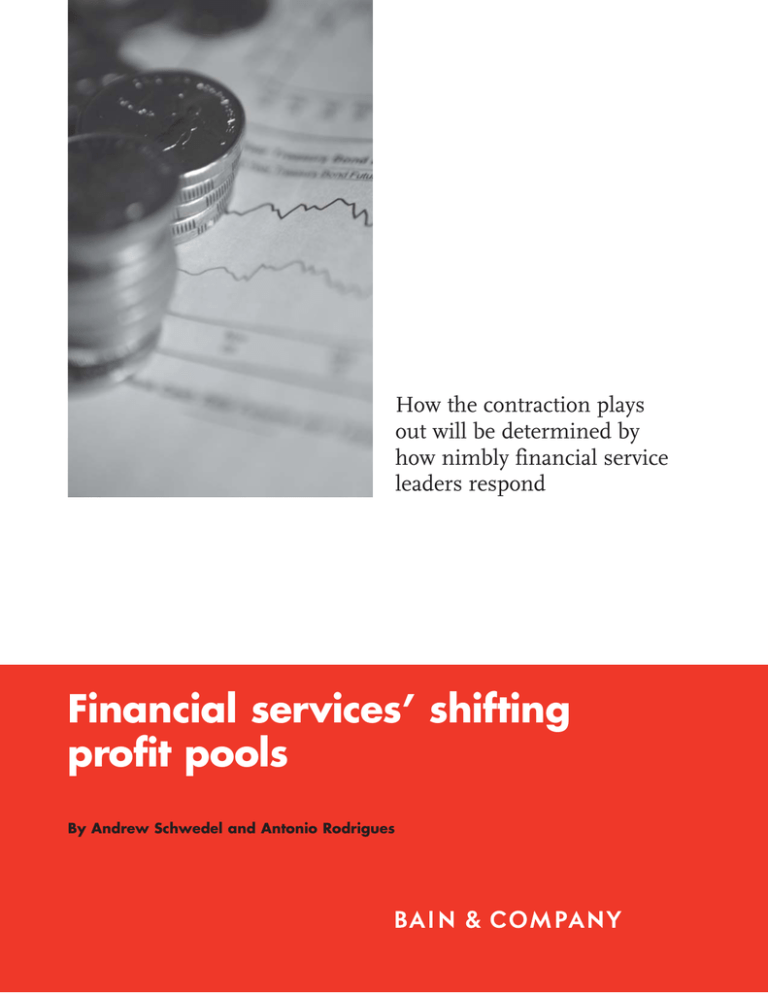
How the contraction plays
out will be determined by
how nimbly financial service
leaders respond
Financial services’ shifting
profit pools
By Andrew Schwedel and Antonio Rodrigues
Andrew Schwedel is a partner with Bain & Company. Based in the New York
office, he leads the firm’s Financial Services practice of the Americas. Antonio
Rodrigues is a partner in Bain’s Toronto office and a member of the firm’s
Financial Services practice.
Copyright © 2009 Bain & Company, Inc. All rights reserved.
Content: Lou Richman, Elaine Cummings
Layout: Global Design
Financial services’ shifting profit pools
How the contraction
plays out will be
determined by how
nimbly financial service
leaders respond
Financial services companies have spent a
long, turbulent spell wrestling with the huge
credit and liquidity challenges that have rocked
the sector. They’ve skirted insolvency, survived
vertiginous drops in asset prices, raised fresh
capital and adapted to tough government
oversight. Unfortunately, much more work
remains to be done.
Despite recent rallies by some commercial
and investment banks, the industry’s structural
profit pools have shifted, with little sign that
they will return to precrisis levels anytime
soon. The sector, which nearly doubled its
share of gross domestic product (GDP) between
1980 and 2007, now faces a major contraction,
as industry returns will lag over the next several
years. Based on Bain & Company analysis,
profits shriveled to $17 billion in 2008, from
an annual average of $430 billion between
2004 and 2007. (See Figure 1.) While the
industry is likely to rebound in 2009, it won’t
regain precrisis levels until 2013.
As they struggle to find their footing amid
continued economic turbulence, all three
major sectors of the financial services industry
—banks, insurers and investment houses—
will remain hobbled by the legacies of past
business practices. How the contraction plays
out across each sector, or affects any particular
company, will be determined by the changed
behavior of customers battered by the downturn and how nimbly the financial service
leaders respond.
Figure 1: Sector profits will not return to historic levels until 2013
Total U.S. financial services pretax profits
$500B
416
412
408
400
346
300
236
200
168
100
49
17
0
2004–07
2007
2008
2009F
2010F
2011F
2012F
2013F
Note: Average (excluding capital markets)
1
Financial services’ shifting profit pools
But at least for the next few years the outlook
is sobering. According to a Bain & Company
analysis, banking returns on equity will not
return to their 2006 peak until at least 2013,
as further credit losses mount. Bain calculates
that the sector is likely to earn at least $200
billion less than its cost of capital over the next
five years—a gap that could widen if the
recession lingers. Insurers face an overhang
of guarantees on annuity and life insurance
policies they have underwritten, leading to
a sharp increase in unrealized losses. Bain
estimates that insurers will need to add some
$65 billion in new capital to restore the
sector’s equity-to-asset ratio to 2007 levels.
Profits in retail asset management will remain
below their cyclical peak through 2013, as
values gradually recover.
Companies will also confront a tougher new
regulatory landscape that will close off some
of their paths to restore earnings and require
them to invest in good scenario planning.
Though specifics are still uncertain, lenders
will almost surely face new consumer disclosure
rules, caps on fees and limits on securitization
that will significantly crimp their profitability.
They will also be required to raise fresh
capital—an additional $200 billion on top
of the $390 billion the big U.S. banks raised
over the past year, according to Bain’s calculations—which will reduce their returns on
equity. Such big changes will force banks to
reassess their current business models. For
example, new rules that will dramatically cut
back overdraft fees will call into question the
basic economics behind the popular “free”
checking account model that has dominated
retail banking for better than a decade.
Climbing out of this hole will challenge financial
service companies fundamentally to retool
three key elements of their businesses where
they retain critical room to maneuver.
2
Customers: Meet the new, new
investor class
As recently as early 2008, U.S. households
were sitting on huge home-equity appreciation,
had retirement nest eggs swollen by stock
market gains and kept their broker’s cell phone
number on speed-dial. Dubbed the “new
investor class” for their enthusiastic accumulation of financial assets, they embraced investment risks, eagerly topped up on credit and
were willing to pay premium commissions and
fees to financial service providers who
promised market-beating returns.
As they ponder their post-crisis future, financial services companies need to reckon with
customers whose assets are depleted, worried
about job security and weighted down by
debt. The financial crisis has fundamentally
changed their views of investing, tempered
their tolerance for risk and diminished their
expectations for investment returns.
The new, new investor class’s chief objectives
will be to pay down debt and rebuild cash
reserves. But even as their savings rate rises
(from just one percent in 2007 to some 7
percent, by Bain’s calculation), the net flow
of household income into financial assets will
be some 20 percent lower on average through
2013 than they were during the flush years
from 2004 to 2008. (See Figure 2.) This
year, Bain forecasts that total flows will plunge
to $390 billion, from $800 billion in 2007.
Given the very shaky balance sheets of middleincome households, the bulk of these flows
will come from high-net-worth customers.
As investment flows contract, financial service
providers will need to wage a high-stakes battle
to attract and retain the smaller population of
wealthier clients whose balance sheets have
held up best.
Financial services’ shifting profit pools
Figure 2: Declining inflows of household assets will make customer retention a top priority
Annual flows into financial assets (nominal dollars)
$800B
736
21% decline
584
600
400
200
0
2004−2008
2009−2013
Source: Federal Reserve, Bain analysis
To attract their share of investors’ dollars,
financial service companies will need to shift
their mix of product offerings away from volatile
investment funds and other asset classes that
offered high returns but required investors to
assume more risk. While reducing debt loads
will be a top priority for most customers, even
investors who remain open to shouldering risk
to rebuild wealth will be looking for simpler,
lower-cost vehicles that provide greater liquidity,
like stock index funds and exchange-traded funds,
or greater safety, like fixed-income annuities.
In the wake of the credit and stock market
meltdown that so undermined their credibility,
financial service providers will need to take
customer loyalty seriously. They have a lot of
ground to make up to regain customers’ trust.
Using a measurement called Net Promoter®
Score (NPS) that Bain & Company codeveloped
with Satmetrix, a customer-experience software
firm, we have tracked trends in customer loyalty
at scores of financial services companies over
the past five years.
With disgruntled customers looking for new,
low-cost ways to save and invest and increasingly open to switching service providers, the
potential prize is huge. Our work across 13
industries in 24 countries has found that
companies that are loyalty leaders capture a
higher proportion of sales from customers
who trust them. They also experience lower
levels of customer churn, which holds down
marketing costs. Their loyal customers, too,
are also more willing to recommend them to
like-minded friends and colleagues who are
apt to become loyalists themselves.
When Bain last surveyed customers of financial
service providers in mid-2009, NPS for the
sector overall had sunk to all-time lows
from where they had been the previous
spring as they absorbed the harsh realities
of the cratering credit and security markets.
(See Figure 3.) The volatile scores suggest
that customer relationships are in play and
that firms that excel as loyalty leaders can
make significant market share gains. They also
point to distinct pockets of opportunity for
some institutions. Specifically, scores for
3
Financial services’ shifting profit pools
Figure 3: Industry turmoil has put customers “in play”
Retail bank client Net Promoter® Score
50%
25
0
25
50
Current NPS
Spring 2008 NPS
75
N=
Bank A
Bank B
Bank C
Bank D
Bank E
Bank F
Bank G
252
65
222
335
257
146
141
Source: Bain retail banking survey
regional banks have held up far better than
those of the troubled big banks. Among brokerage firms, the traditional high-cost wirehouses have lost significant ground to the
independent broker dealers that have worked
to position themselves with investors as
value-oriented trusted advisers.
The brokerage firm Charles Schwab is seizing
the advantages of loyalty leadership to pull
away from the competition during the downturn. Over the past five years, the company
has driven disciplines of customer focus
deep into the organization, empowering
branch office staff to convert clients into
advocates and holding them accountable for
results. Schwab is beginning to reap the
rewards of that patient investment. In a year
when retail investors were pulling money
out of tumbling markets, the brokerage business
grew by $113 billion, as the company posted
record operating profits.
4
Costs: Rethink the business
model for deep savings
As revenues rose sharply with economic
expansion through the end of 2007, banks,
insurers and asset managers felt little pressure
to hold down operating expenses. But with
customers more price sensitive than ever
and profit margins squeezed, they need to
dig in much deeper to bring down costs.
They have a long way to go. To restore 2011
returns to 2007 levels, for example, life insurers
and asset managers will need to find some
$15 billion in cost savings, according to Bain’s
analysis. Among banks, the cost savings have
not kept up with shrinking interest and fee
income or with the big jump in provisions
they have been forced to make to absorb losses
on nonperforming loans. They will need to
lower costs by $45 billon by 2012 to regain
returns on equity that prevailed in 2007.
Financial services’ shifting profit pools
For the financial services sector as a whole,
cost reductions on the order of 9 percent to
15 percent will be needed to bring costs in
line with lower revenues. Much progress has
been made, but there is still a long way to go.
Conventional approaches are apt to fall short.
As they enter a period of higher capital costs,
more stringent regulatory oversight and
pinched profit margins, companies will need
to rethink their business models to succeed.
By homing in on core business activities where
they can exploit competitive advantages, tomorrow’s winners will burrow deep into their
organizations to identify and strip out the
product, process and organizational complexity
embedded in their businesses.
The cost of complexity was especially insidious
for financial services companies during the
past expansion, in part because it was all
but invisible and grew without restraint.
Companies slipped into a trap of adding
products and services that piggybacked on
existing offerings and modestly increased
customer support to serve the new accounts.
But the apparently low incremental costs
proved deceptive because they masked the
steep, hidden systemic costs that built up in
underlying processes. Now, with customers’
appetite for variety sated, many financial
service providers find themselves struggling
with a huge overhang of complexity and all
its costly consequences.
What to do? Cutting structural costs deeply
while simultaneously strengthening customer
loyalty is a big challenge for any company
to pull off. Trying to root out complexity by
paring back on product offerings or shutting
down business lines, for example, does not
eliminate the need to continue to serve accounts
held by legions of legacy customers. But the
challenge is far harder for financial services
organizations that continue to add complexity,
as many are still doing in response to market
pressure to reduce their perceived risk by
diversifying. In fact, what’s called for in
today’s straitened times is to focus clearly on
the few competitive battlefields where the
company determines it is best able to compete.
Service companies that succeed in tackling
complexity start with a blank sheet of paper.
They begin by calculating what their cost
structure would look like if they were to offer
just one product—the stripped-down “Model
T” approach. Then, they cost out each new
product variant as new features are added
back in. Companies that put themselves
through this exercise typically find that costs
do not rise in a linear fashion but rather
jump sharply at break points where added
complexity starts to strain against capacity.
Knowing where those break points occur—
and how to avoid them—can spell the difference between healthy profitable growth and
subpar performance.
Some pioneering banks in Europe and in fastgrowing emerging markets are putting this
insight to work by fundamentally rethinking
how to operate their branch networks more
like retailers to boost customer traffic and
radically reduce costs. Applying a concept we
call light-retail banking, they are stripping
branches of costly transaction-processing
activities, shrinking their footprint and
converting branches into attractive boutiques
that focus on product sales. Construction
and operating costs for a compact bank
“store” are less than one-quarter of those of
a standard branch. Several U.S. retail banks
have begun applying light-retail principles to
their branch networks, but most still need to
integrate the approach more completely with
the services they offer online and with their
back-office customer-support operations to
achieve the full potential of the new approach.
5
Financial services’ shifting profit pools
The second critical step for wringing out
complexity is to zero in on what customers
truly value. Working with clients from a variety
of industries, Bain has discovered that typically
5 percent of a company’s products can account
for up to 95 percent of its sales.
Finally, organizations determined to steer
clear of complexity remain perpetually vigilant.
Customers and competitors don’t stand still,
and as financial service companies race to
innovate, the likelihood is high that complexity will creep back in. Smart companies avoid
this by putting safeguards in place to keep
their business model simple. They raise the
hurdle rate any new product or service must
clear before it is added to the portfolio. And
they “prune the garden” by eliminating or
streamlining an existing product when a new
product is added.
Capital management: Recognize
how risk affects profitability
The fundamental blind spot at the heart of
the financial services sector meltdown has
been an institutional and systemic failure to
assess risks properly and put safeguards in
place to control them. Poor risk management
led banks and other financial companies to
miscalculate their true profitability and, as
a consequence, to commit scarce capital to developing and marketing the wrong products, and
using the wrong incentives to reward “success.”
For many companies, the source of the problem has been to run their businesses paying
insufficient attention to their true risk-adjusted economic profits. Economic profit begins
with the net after-tax accounting profit but
then critically adjusts for the amount and
cost of the equity the company commits to
put at risk. Thus, when measured on a riskadjusted basis, the economic profits associated with a given product, customer segment
or market will likely be significantly lower
6
than accounting profits—potentially turning
an activity that appears to kick off healthy
profits into a money loser.
While the big financials services companies
did try to account for risk and capital costs in
the period leading up to the credit meltdown,
most failed to factor it appropriately into
their decision-making processes. In some
cases, information remained bottled up in the
finance department and did not reach businessunit heads who tried to optimize gross revenues
or other performance measures. In other
instances, they may have made their estimations
based on faulty assumptions. For example,
banks did recognize the need to adjust for
risk the capital they committed to underwriting
mortgages, but their formulas massively underestimated how big that risk could be in a
scenario where housing prices collapsed
nationally, leading homeowners to default in
unprecedented numbers.
Clearly, a more realistic appraisal of risk and a
more integrated approach to managing capital
needs to play a much more prominent role in
today’s more sober times. As they recalibrate
their expectations going forward, for example,
financial service companies are taking a
renewed interest in attracting plain-vanilla
deposits as a surer source of stable funds to
support long-term asset growth.
Financial services companies that respond to
the painful shift in profit pools by taking on
the hard work to strengthen bonds of trust
with loyal, more parsimonious, customers,
squeeze complexity out of their core businesses
and do a smarter job of managing scarce
capital may not get the quick earnings kick
the sector once enjoyed through leverage and
by embracing risk. But they will surely earn
a sustainable competitive edge that their less
focused rivals cannot match.
Financial services’ shifting profit pools
Notes
7
8
Financial services’ shifting profit pools
Bain’s business is helping make companies more valuable.
Founded in 1973 on the principle that consultants must measure their success in terms
of their clients’ financial results, Bain works with top management teams to beat competitors
and generate substantial, lasting financial impact. Our clients have historically outperformed
the stock market by 4:1.
Who we work with
Our clients are typically bold, ambitious business leaders. They have the talent, the will
and the open-mindedness required to succeed. They are not satisfied with the status quo.
What we do
We help companies find where to make their money, make more of it faster and sustain
its growth longer. We help management make the big decisions: on strategy, operations,
technology, mergers and acquisitions and organization. Where appropriate, we work with
them to make it happen.
How we do it
We realize that helping an organization change requires more than just a recommendation.
So we try to put ourselves in our clients’ shoes and focus on practical actions.
For more information, please visit www.bain.com








